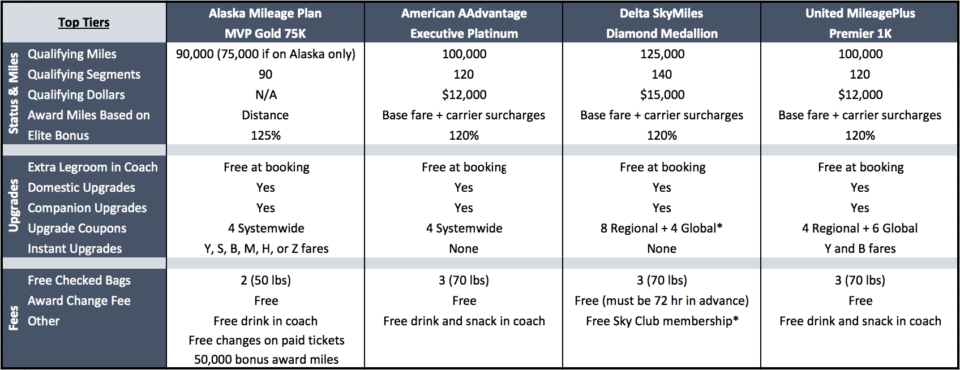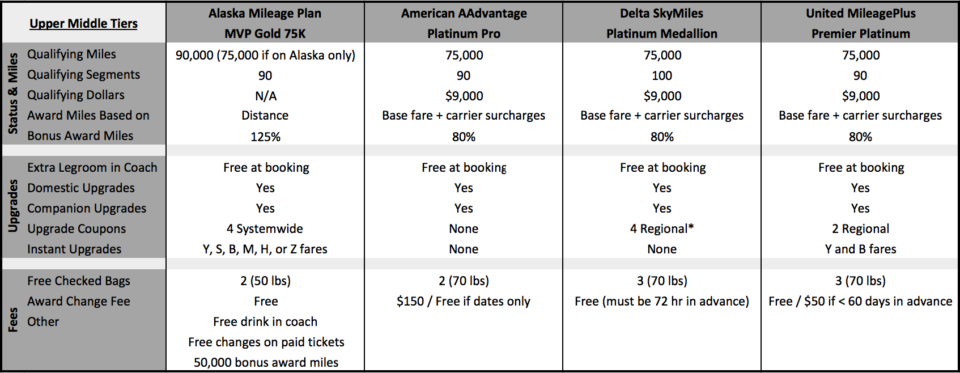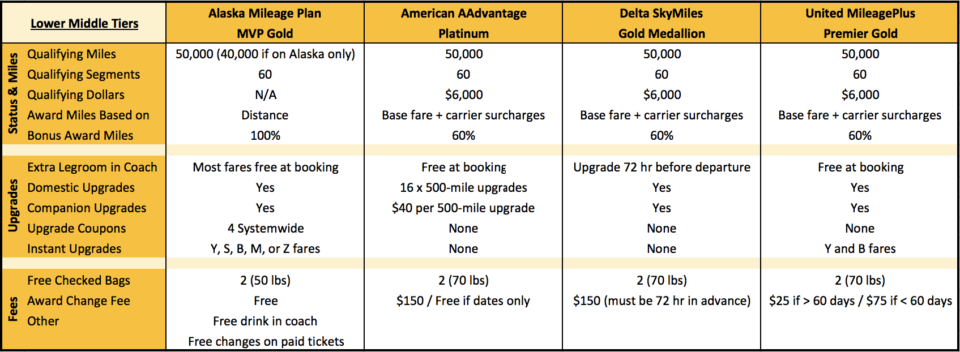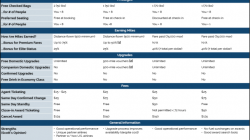Now that the new year is here, elite qualification clocks have reset and it’s time to take a fresh look at your options. Which airline offers the best elite benefits, or should you ditch the programs completely to become a free agent?
We saw some consolidation in the airline industry in 2017, with Alaska Airlines completing its acquisition of Virgin America. JetBlue and Southwest Airlines remain exceptions with their revenue-based programs. And the triumvirate of Delta, American, and United continues to dominate the domestic and international market for travelers in the United States.
In this post I’ll compare the four mainstream loyalty programs—United MileagePlus, American AAdvantage, Delta SkyMiles, and Alaska Mileage Plan—on measures including qualification criteria, upgrade rules, bonus miles, and more. Discussion of JetBlue Airways and Southwest Airlines will wait until the end of the post. They’re big carriers, particularly Southwest, but the structure of their programs is so different that it isn’t meaningful to make a comparison to the other four. How, for example, can one compare upgrade requirements when one airline doesn’t even have a first class cabin? (Those still interested can also read Sriram’s introduction to Southwest Airlines.)
If you spot an error, feel free to suggest a correction in the comments. We might also be interpreting the same thing differently, and some nuances can’t be summarized easily. I’ve been comparing airline status since 2012; it’s always a work in progress! Click on the images for a larger picture.
Top Tier Status with 100K+ Miles
Note: The Big Three each have four elite tiers, while Alaska Airlines has just three. I’ll be including Alaska’s MVP Gold 75K top tier in this chart as well as in the next chart that follows. For similar reasons, I’m including Delta’s top tier here even though the requirements are higher.
Delta is unique in offering Medallion Choice benefits that let customers with Diamond or Platinum Medallion status choose their elite benefits. Platinum Medallions get only one selection from a limited list, while Diamond Medallions get three selections from a larger list. I’ve made assumptions here that a Diamond Medallion member will choose 8 Regional Upgrades, 4 Global Upgrades, and one Sky Club membership. (This an individual membership; you can redeem two choices to get a membership that includes guest access. Other options include 25,000 bonus miles or Gold Medallion status for a friend.)
Winner: United Airlines and Delta Air Lines are running neck-and-neck again. It may come down to where you live and how often you fly each year, since no one wants to try to earn 125,000 miles on Delta if they aren’t already located near one of its hub airports.
I’ve flown both carriers in the past year in economy and first class and preferred United, which has improved significantly under the new management of Oscar Munoz. United offers more Global Upgrades, a lower qualification requirement, instant upgrades on some full-priced economy class tickets, and an impressive new business class cabin (admittedly, it faces significant delays). However, there are ways to make Delta’s program more rewarding with your Medallion Choice benefits, particularly if you are a solo traveler.
Upper Middle Tier Status with 75K+ Miles
Again, Delta offers some flexibility with its Medallion Choice benefits. I made an assumption that this Platinum Medallion member would choose 4 Regional Upgrade, but other options include 20,000 bonus miles or Silver Medallion status for a friend.
Winner: Delta’s Platinum status is much more attainable than Diamond status while offering some great perks including four Regional Upgrades and three free checked bags. It matches or exceeds United and American on most measures. While some aspects of Alaska’s MPV Gold 75K tier are obviously superior–over 50% more bonus miles on every flight and and an additional lump sum of 50,000 award miles each year–the qualification criteria are tricky. To earn it you’d need to fly 75,000 miles entirely on Alaska Airlines, Horizon Air, or Virgin America. That’s hard to do on a network that is mostly domestic, yet traveling on partner airlines increases the threshold to 90,000 miles.
Lower Middle Tier Status with 50K+ Miles
Alaska Airlines technically requires an upgrade for access to its Premium Class with extra legroom in economy. However, the majority of fares are eligible for instant access at the time of booking.
Winner: Alaska Airlines often wins this match thanks to the free flight changes, regional upgrade coupons, and large bonus on award miles. You can even earn status at a lower threshold if you only fly on Alaska Airlines, Horizon Air, or Virgin America flights. For the moderately frequent flyer it’s a great set of perks that don’t require weeks away from home. However, Alaska recently ended its partnership with Delta Air Lines and imposed new restrictions on its partnership with American Airlines, making it much harder for travelers on the East Coast to justify the investment. They would do well to look at United or Delta instead.
Lower Tier Status with 25K+ Miles
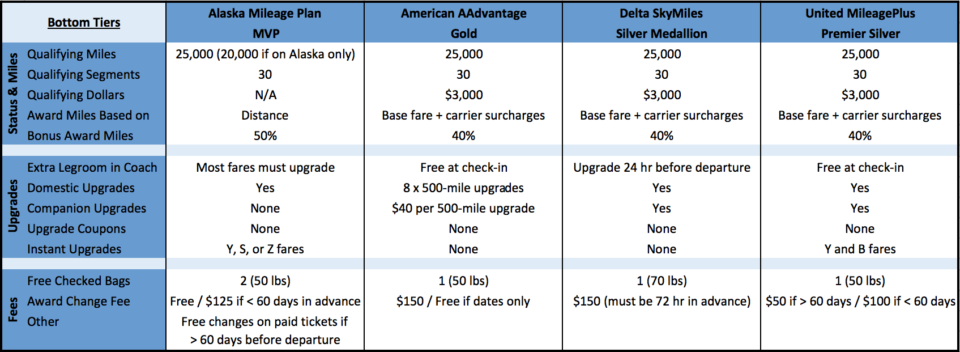 Access to economy class seats with extra legroom is more complicated among the lower tiers. Delta Air Lines makes this an upgrade-only benefit that will be processed based on fare class and availability. American Airlines and United Airlines provide it at check-in, which means you need to be first to beat the rush. Alaska Airlines follows an upgrade system like Delta, but some fares are eligible at the time of booking.
Access to economy class seats with extra legroom is more complicated among the lower tiers. Delta Air Lines makes this an upgrade-only benefit that will be processed based on fare class and availability. American Airlines and United Airlines provide it at check-in, which means you need to be first to beat the rush. Alaska Airlines follows an upgrade system like Delta, but some fares are eligible at the time of booking.
Winner: This match up is a tie between Alaska Airlines, American Airlines, and Delta Air Lines depending on which perks you value most. Alaska offers additional free checked bags and bonus award miles but limited companion benefits. American offers a chance to buy your way onto the upgrade list–unpalatable, but perhaps offering better odds than the free-for-all of unlimited upgrades. Delta’s benefits are not much different from United, but it is easier to attain thanks to the Medallion Qualifying Dollar waiver available with certain Delta co-brand credit cards from American Express.
Distance- vs. Revenue-Based Programs
You might have some questions about how miles are actually calculated after reading the charts above, so let me explain an important difference between distance-based programs and revenue-based programs.
Alaska Airlines remains the only carrier in the United States to have a distance-based program, which means that it uses the distance you fly to calculate the number of miles you earn. It uses distance for both elite qualifying miles and redeemable award miles and does not track of elite qualifying dollars. Alaska’s flights earn 100% of the distance flown in base miles (partner flights have a different percentage). Certain fare classes earn a bonus that applies to award miles AND elite qualifying miles. Then there is an elite bonus based on status, and this applies ONLY to award miles. I have listed this elite bonus in the charts above.
United, American, and Delta calculate things differently. Award miles are based ONLY on the price of your ticket, which includes base fare and carrier-imposed surcharges but not government taxes. This ticket price is multiplied by a factor that varies with status: 5x if you have no status, and either 7x, 8x, 9x, or 11x if you do have status. So a ticket you pay $1,000 for might actually be just $800 after subtracting taxes. It then earns between 5 and 11 times that $800 amount. This greater multiple is the bonus I list above, e.g., 7x is a 40% bonus on the standard multiple of 5x.
Elite qualifying miles and elite qualifying dollars are more complicated for these three legacy programs. Each is a little bit different, and I will not discuss the differences here. But in general you elite qualifying miles are equal to distance flown, and elite qualifying dollars are equal to base fare plus carrier imposed surcharges (that would be $800 in the example earlier, not $1,000).
Southwest Airlines and JetBlue Airways
There are two other major airlines in the United States that have true revenue-based programs. Why “true”? Well, the big three are really only half-way there, using revenue to calculate how many miles you earn but not how many miles you redeem. Their award charts are still based loosely on distance.
JetBlue’s TrueBlue program and Southwest’s Rapid Rewards program are entirely revenue-based on both the earning and redemption sides of the equation. Their loyalty programs are also less complex because they have fewer benefits to offer (most flights have no first class cabin, among other reasons).
In general less complexity means less rewarding, but the value is only there if you can figure it out. One model is not necessarily better than the other—just different.
JetBlue TrueBlue
JetBlue TrueBlue members earn 3 base points per dollar on every flight and an additional bonus of 3 to 5 points per dollar that varies with the fare type.Points can be redeemed at between 1.5 and 1.7 cents each for a future ticket on JetBlue.
You can earn TrueBlue Mosaic elite status (one tier only) after either earning 15,000 base points or earning a lower amount of 12,000 base points and flying 30 segments. Mosaic status includes two free checked bags (50 lbs), 15,000 bonus points, and a complimentary alcoholic beverage.
Southwest Rapid Rewards
Southwest Rapid Rewards members earn between 6 and 12 base points per dollar depending on the fare type. Additional bonus points are awarded with elite status. Points can be redeemed for about 1.5 to 1.6 cents each.
Travelers already get two free checked bags (50 lbs) without elite status, but three elite tiers do exist. A-List status is earned after 25 one-way flights or 35,000 base points and comes with 25% bonus points. A-List Preferred status is earned after 50 one-way flights or 70,000 base points and comes with 100% bonus points.
Finally, the Companion Pass is earned after 100 one-way flights or 110,000 base points. It is not status per se but does allow the traveler to designate one companion who can travel free for one year, but only on the same reservation as the primary traveler.

